Zipcars are coming to Chico State University, the first campus in the California State University system to offer the rental car system designed to ease traffic and parking congestion and provide students with an optional method of transportation.
The campus was scheduled to receive the first cars this week from the Cambridge, Mass.-based Zipcar, which provides vehicle rentals by the hour or day. Students need to sign up for the program and they’ll then receive a contactless card that will provide access to the vehicles that will be strategically placed about campus. There is a $25 application fee and $50 annual fee.
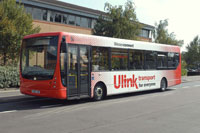 Ulink, the bus service operated by the University of West England and Wessex Connect and originally established for students, introduced this month an Oyster-style card for passengers to make their travels across Bristol easier.
Ulink, the bus service operated by the University of West England and Wessex Connect and originally established for students, introduced this month an Oyster-style card for passengers to make their travels across Bristol easier.
Now in its second year, Ulink became the first bus service in Bristol to successfully launch the new smart card system. Modeled after London’s Oyster card, students and Bristol’s bus users can avoid the hassle of long lines and scrambling for change by taking advantage of this new scheme.
“The idea is that you get on the bus and instead of having to find the right cash to buy a ticket, you put your smart card onto the ticket machine as payment,” said Steve Ward, UWE’s travel planner. “The machine still gives you a ticket but the time wasted at the stop is reduced.”
Ward hopes Bristol’s City Council will consider installing the smart card system on Bristol’s other bus services. “It’s cheaper, more convenient and you don’t have to worry about having the right money. When the balance on the smart card gets low, you can just pay the driver to top it up.”
When Hope College in Holland, Mich. had to close campus in the middle of the day last fall due to a virus outbreak, it alerted everyone with a text message. While it’s the only time so far that the new alert system was used, it’s a good illustration of how many universities and colleges are looking for ways to make their campuses safer.
“The instructions in those text messages can be very brief, almost Twitter-length,” said a Hope College spokesperson. “You can either give instructions or just tell them to go to the college’s Web site, where we can immediately update the status of what’s going on.”
At another Michigan university, students can sign up for a text-message alert system that will inform them about everything from crime to inclement weather.
Read more here.
Depauw University in Greencastle, Ind. is now enabling its students to use their campus card at nine restaurants off campus. The program will be managed by Off-Campus Advantage, a subsidiary of campus card provider CBORD.
The restaurants will give 9.5% of each transaction to DePauw and also pay a software fee that will allow their credit card machines to accept the school’s campus card. Part of DePauw’s percentage will be paid directly to Off-Campus Advantage, that will monitor all transactions and make sure the money ends up in the right hands.
 Making social media work for your campus card program
Making social media work for your campus card program
By Andy Williams, Associate Editor, Avisian Publications
If you aren’t using Facebook, YouTube, MySpace or some of the other so-called social networking sites, you may be missing out on a prime opportunity to market your campus card or other university program.
The University of Minnesota uses Facebook, YouTube and sometimes Twitter to keep its students in the know and coming soon will be an ambitious video about the day in the life of a U Card user, said Alison Bloomster, marketing and operations manager, U Card Office, at the university. “This is where your students are, and this is where you need to be,” she said.
Bloomster showed attendees at the NACCU conference in March ways to use these sites and did a repeat performance during a NACCU-sponsored Webinar in June.
“Social media is a huge evolving topic which you can use to augment your current marketing plan. It’s a great way to get in touch with students as well as faculty,” said Bloomster. More importantly, today’s students, sometimes labeled millennials, or Gen Y, expect this, she said.
To develop the best strategy for using social media, universities need to understand what the core users of this technology want, said Bloomster. Play to some of the traits the generation exhibits. They feel they are special because they have been treated with kid gloves and have had high parental involvement in their upbringing. They also are confident, team oriented, believe social rules are good because they provide order, have been pushed by their parents, faculty and peers to work and study hard, and are achievement oriented, she adds.
And they’re technology natives. They are part of a generation that has always had access to cell phones and computers.
Non-traditional channels
The choices available for marketing are infinite, she said. “You have the Web, email, blogs, instant messaging, picture sharing and VoIP (Voice over Internet Protocol, a system that enables phone calls via the Internet).” None of these choices existed even a few years ago. “I really believe that social media fits best with promotion. It gives you another way to be visible on campus,” said Bloomster.
“What makes social media different is that it’s interactive. You don’t have to know html to post pictures anymore. It’s a way for people and for you to connect to your customers, your cardholders. When you’re moving into the realm of interactivity, you’re creating channels of social media, where you and other users are connecting with each other,” she explained.
Still Bloomster views social sites as simply an extension of a university’s overall marketing and promotion program.
“Social Media the noun can refer to all the Internet and mobile-based channels and applications that people use for sharing and interacting around text, photo and video based information,” she added. “It’s a channel of communication in which the audience can participate by adding comments, instant messaging, or editing the story themselves.”
The university has its own Facebook site. You have to be a member to view the pages which means you’re either a university employee or a student. “We decided to use Facebook because it’s very user friendly. We’ve uploaded photos, we do wall postings, and we have used Facebook for promotions.”
Another site used by the university is a popular video-sharing site. “YouTube is amazing,” she said. “You can create your own channels. We have a channel there and we’ll be posting our video blog (a day in the life of a U Card) there once it’s finished.”
Regardless of the social media you’re using, don’t be afraid to experiment, she suggested. That’s the only way you’ll learn what will work best for your institution. “There is no magic bullet here. Some will make sense, like wall postings on Facebook.”
The university also started using Twitter, sending out, in Twitter parlance, “tweets,” little messages your Internet-capable phone can capture or you view on your computer. This works really well during peak enrollment periods or recarding. “You could check to see, hey there’s an hour wait right now,” said Bloomster. A tweet is limited to 140 characters and it’s not used “so much by students, but it is by staff and faculty,” she added.
The media, at least for now, is free and paperless, which also makes it environmentally friendly.
Bloomster supplied some suggestions about using social media:
“Think about all that we know about the millennial generation, all the workshops we’ve been to and apply that to using social media,” she said.
Remember that interaction is key. “Information should be interesting and useful. Play into the tastes of your audience, the millennial generation and their parents,” she said.
Promote your social media, whether it’s your Facebook page or Web site, via email. “Millennials are content providers and will want to post their comments on your site, such as their experiences with the campus card,” said Bloomster.
To millennials social media is a lifestyle. “It’s really important you recognize that,” she added.
Two more universities have signed up with TipNow, the San Jose, Calif.-based text messaging service designed to increase campus safety by allowing students to anonymously notify campus security personnel regarding non-emergency suspicious activity.
California Polytechnic State University in San Luis Obispo and Quinnipiac University, Hamden, Conn., are now offering the new service from Resiligence, Inc., which is looking to deploy the system with other universities, city police departments and corporate campuses.
TipNow is a tip collection and management system for anonymous tips originating from electronic mail and cell phone/personal digital assistant SMS or text messages. TipNow encrypts the reporter’s cell phone number or email ID, guaranteeing anonymity.
It is offered in the software as a service model which means it does not require any hardware installation or servicing by the user. TipNow also allows campus safety personnel to anonymously interact with the reporter.
Students returning this fall to Elizabeth City State University in North Carolina will find waiting for them a revamped student ID card with more services. While previous versions of the card granted users access to campus buildings and the stadium, the new VikingOne card will also have debit capabilities for use on-campus only at vending machines, the campus restaurant and the campus book store.
“Students have to have a separate card for everything, so this will be a major advantage for us,” said a university spokesperson. More services are likely to be added to the card by next spring, the official noted.
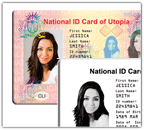 Often the emphasis is on the security used to protect the data stored in a card, but what’s equally as important are the security features techniques used to protect the data printed on the card itself.
Often the emphasis is on the security used to protect the data stored in a card, but what’s equally as important are the security features techniques used to protect the data printed on the card itself.
Laser engraving is nothing new, but the price is dropping and more customers are looking at the security feature, says Jonathan Bowen, sales manager at Digital Identification Solutions. The Greer, S.C.-based company released the EDIsecure LCP 9000 Laser Color Personalization System last year, one of the first desktop laser engraving systems that sells for less than $100,000.
Digital Identification Solutions is targeting the printer to the driver license and government markets in the Americas, Bowen says. “Those who have huge issues with forged and faked cards are our primary customers,” he says. The company is expecting to ship its first units this fall.
Laser engraving is a technology that burns data into an ID card or data page in a passport. It enables standard text and images to be added as well as special security features such as microtext, tactile data, perforated images , and variable images that change with different viewing angles.
Laser engraving can be conducted on various materials, but it works best with documents made of polycarbonate. When a laser beam is applied to the polycarbonate substrate, the heat causes a chemical reaction that essentially burns, or carbonizes, a minute area changing it from white to black. Repeated and controlled application of the laser creates the text and images within the card.
This carbonization process occurs at the material’s core and extends up to the surface of the document. Thus laser engraved data cannot be scratched or peeled off of the document because it truly becomes a component of the card’s construction. The ability to modify a valid laser engraved document for fraudulent use is virtually impossible.
When a laser is applied to a specially-designed polycarbonate card, it penetrates the transparent outer layer and reacts with a carbon-enriched layer. This reaction creates a dark colored material that moves through the card to its surface. Both the front and the back of the card can be engraved separately.
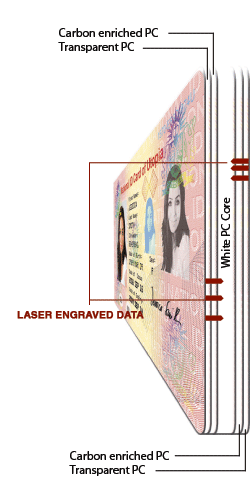
Overseas more governments are using laser engraving or looking at the technology as well, says Chris Dyball, chief operating officer at Lasercard Corp. The Mountain View, Calif.-based company provides national ID systems to a number of countries. Costa Rica’s national ID and the U.S. and Canada’s Permanent Resident Cards each use laser engraving, he says.
As governments are looking for better ways to secure documents many are finding a solution in laser engraving. “The predominant way of creating images on a card was dye transfer but many are transitioning to laser engraving,” Dyball says.
But with dye sublimation printers a fraction of the cost of laser engraving why make the switch? “Laser engraving makes it difficult to remove or alter the card information,” Bowen says. “The normal person who wants to fake the card won’t bother with it, he’ll move on to another target. It’s also expensive enough to keep the criminal element away and technical enough to where if he got it he wouldn’t know what to do with it.”
Laser engraving actually burns the information into the card, Bowen says. “It burns through the top level and reacts with the inner card body,” he says. “It’s impossible to scratch the information off or remove it with chemicals.”
Information can sometimes be removed or changed from cards printed on dye sublimation machines, Dyball says. “The image is essentially at the surface,” he says. “You can then put a overlay over the dye transfer image but even when you do that you can peel off the patch and take solvent or a mild abrasive and remove it and the fraud would be difficult to detect.”
Dye images can also suffer over time, Dyball says. Temperature and humidity can affect the images over time causing them to fade.
Laser engraving also creates a tactile security feature on the card, Bowen says. When the information is burned into the card body it creates raised ridges that can be felt, similar to an embossed credit card. “When a state trooper pulls someone over and only has a few minutes to validate an ID the tactile feature is great,” he says. “It’s virtually impossible to forge on a desktop printer.”
Laser engraving also has the ability to print changeable laser images and multiple laser images on cards, Bowen says. This enables an issuer to print a last name and date of birth in the same area but depending on what angle you hold the card what is seen changes. For example, at one angle an individual will see the name but at another he will see the date of birth.
To enable this feature an issuer has to make some changes to its card stock manufacturing process and place a small lens on the card body. The laser will then burn the information in at different angles to enable the feature. “It’s a security feature you can see with the naked eye and it’s impossible to create with any other type of desktop printer,” Bowen says.
Laser printers have another advantage, no consumables, such as printer ribbons, Dyball says. People with widely distributed issuance sites are looking at laser engraving because of the savings on consumables,” he says. “You have an upfront investment but savings over time.”
The high cost is one drawback to laser engraving, another is the inability to print color images, Dyball says. “Laser engraving over the past few years have gotten better at gray scale images,” he says, noting that current engravers can modulate the pulse of the laser and get much better gray scale images.
Some still want color, though, and use both dye sublimation and laser engraving. “We have a customer in Italy who buys the card bodies and color prints the photos and laser engraves the text,” Dyball says.
As counterfeiters get more sophisticated and governments want to increase security, laser engraving is one solution they may look at.
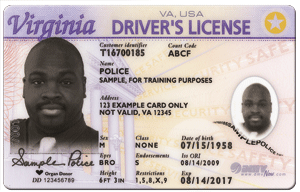
This summer, the State of Virginia’s Department of Motor Vehicles began issuance of a new, more secure driver license.
The ID has two laser engraved photos, one of which appears in a clear window that is visible from the front and back of the card. It also uses security lettering and ultraviolet features to verify authenticity.
The state has also moved to a centralized issuance model. Rather than producing licenses in the local offices, all credentials are produced in a secure, central production facility. Located in Danville, Va., the site is comparable to a credit card production center with high levels of security and restricted access.
Virginians still go to a local service center to apply for licenses and ID cards, have their photographs taken, and get a temporary 30-day permit to be used until actual card arrives via mail.
A Finnish company called Setec Oy brought laser engraving to the ID document world in the late 1980s when they began issuing engraved driver licenses in Finland. In 2005, Gemplus now part of Gemalto, purchased Setec citing the company’s “expertise in the security printing and polycarbonate business,” a clear reference to the laser engraving capability. The laser engraving process, however, is not patented and a number of companies provide the technology to the ID marketplace.
National ID, Passport & Driver License programs that have issued or will implement a laser engraved polycarbonate document:
Driver License
National ID Card
Passport
Other
Source: Ian Williams, Identity Systems Group Inc.
The University of Memphis, one of two Tennessee schools without a mandatory on-campus dining program, plans to change that starting with the fall semester when all full-time freshmen and sophomores will automatically have $300 charged to their student accounts. Dubbed “Dining Dollar$,” the money will be placed on their student ID cards.
While initially designed to increase food sales, it’s also meant to get students to eat on campus with friends, classmates and professors, which administrators believe will enhance their interactions with peers, said a college administrator.
While usage is light, hand scanners are starting to make their presence felt on some college campuses
By Andy Williams, Associate Editor, Avisian Publications
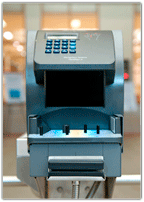 Biometrics aren’t exactly taking the college world by storm but it is gaining traction in some areas. While the technology can be expensive, some schools are finding uses that both aid in identification and, in light of the current budget crunches, recoup what otherwise might be lost income.
Biometrics aren’t exactly taking the college world by storm but it is gaining traction in some areas. While the technology can be expensive, some schools are finding uses that both aid in identification and, in light of the current budget crunches, recoup what otherwise might be lost income.
Most campus card providers offer biometrics as an option to their college clients. And most of these providers use what can only be described as the big biometric provider on campus, Ingersoll Rand.
“We’re on most campuses because we have a broad product line that includes door locking systems as well as biometric readers,” says Bob Bazemore, director, education solutions, Ingersoll Rand.
Bazemore estimates IR is on some 100 campuses, mostly in the U.S. Surprisingly, the biometric of choice isn’t a fingerprint reader but one that reads the hand geometry.
Read Winkelman, vice president of sales for colleges and universities at The CBORD Group, says biometrics is viable in certain situations. “We haven’t seen the demand for biometrics as the primary credential, but have seen it as a form of secondary authentication, usually in higher security areas, such as computer labs.” He says about ten CBORD schools have biometrics installed, nothing “a number are research institutions with very expensive equipment.”
Some CBORD schools do use a fingerprint reader, but it’s for employees and is used with CBORD’s point-of-sales system. “As with most POS terminals, registered operators log in to begin their shift. Often this is done with an employee card that is swiped. We have customers who use a fingerprint reader for this purpose instead. They register their fingerprint in the database and use it to log in. We have five or so customers using this application,” says Winkelman.
Heartland Campus Card Solutions can also offer fingerprint scanners if their clients want it, but none have asked for it yet, says Fred Emery, Heartland’s vice president and general manager. Some say there are privacy issues with fingerprints. “They’ve gone with the hand. It seems less obtrusive,” says Emery.
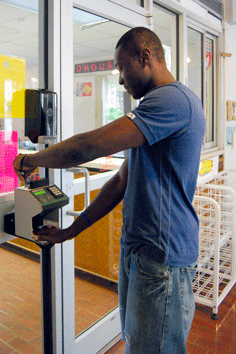 The University of Georgia has been using hand scanners since they were first created. The Athens, Ga.-based school has had lots of time to experiment with scanners and has had such scanners, and its different versions, in place for more than 35 years. The scanners are primarily used in food services, campus recreation and dorm access, says William McGee, manager of UGACARD Services at the university.
The University of Georgia has been using hand scanners since they were first created. The Athens, Ga.-based school has had lots of time to experiment with scanners and has had such scanners, and its different versions, in place for more than 35 years. The scanners are primarily used in food services, campus recreation and dorm access, says William McGee, manager of UGACARD Services at the university.
Obviously the university has upgraded its scanners since that first 1972 installation. “The first hand scanner was about the size of a 20-inch TV,” says McGee. “It’s a beast.” The company that first installed that scanner later became part of Ingersoll Rand. The university is now using IR’s HandKey 2 scanner.
The university requires either an ID card or the ID number to be physically entered in addition to the hand scan. The ID number is nine digits long. “It’s not a hard number to memorize. Most have it memorized in the first week,” says McGee of the school’s 37,000 students.
“Biometrics takes security to a new level,” says McGee. You’re dealing with something you have (the ID card or something you know (PIN) in addition to something you are. “Even if you knew my ID number, your chances of getting in with your hand is impossible and reader locks down after the third attempt,” he says.
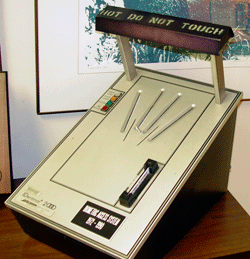 An Old hand reader once used by UGA.
An Old hand reader once used by UGA.As far as read times, 30 years ago it was probably in the three or four second range, but now it’s much less, says McGee. In addition the scanners have gone from a one-to-many comparison to one-to-one.
Dining services was the group that first brought it to campus. “They were looking for a better way to identify patrons than the meal token, something that could provide quick and easy access. We have an all-you-can-eat program, so whether you come once a day or 20 times a day, you can get service. With a hand scanner you don’t have to have staff to physically check the card,” says McGee.
He says the university upgraded to HandKey 2 because it provided “better read quality and an outline of the hand so students know where to place their hand. It also includes an antibacterial platen to cut back on germs,” adds McGee.
Even twins can’t fool a scanner
The university is also experimenting with different uses for the scanner. “We had a request from a faculty member who wanted to verify if the right students were taking a test.” When students come in, they perform a hand scan and swipe their card and the reader turns red or green so the professor can see at a glance if the student deserves to be there.
“This will prevent other students from taking the test. You can adjust the tolerance to where it’s very strict. We have twins who do not show up the same. We had a set that tried to share a meal plan, and that’s how we caught them,” says McGee.
A convenience for students
 Colleges need a good cost saving reason to think about using the technology, says Emery. Budget shortages could be holding the hand scanning technology back because they are more expensive than a mag-stripe reader or PIN pad.
Colleges need a good cost saving reason to think about using the technology, says Emery. Budget shortages could be holding the hand scanning technology back because they are more expensive than a mag-stripe reader or PIN pad.
Two Heartland clients are Emory University, Atlanta, and Hofstra University, Long Island, N.Y. - have biometrics systems in place, says Emery. “They use hand geometry scanners from Ingersoll Rand integrated into our solution so they communicate to our access control software.”
For Emory University, hand scanners are about student convenience. The school uses them at one of its recreation facilities so students don’t have to carry a card to get in, says Emery.
At Hofstra, they were to increase security in some of the residence halls and entry ways. “They wanted to harden access to the dorms and to make sure a student couldn’t hand the card out the dorm window to another student for access,” Emery says.
For ease of use hand geometry is great, however, it’s not for all buildings. “If you go into a computer lab or library, a lot of campuses would feel it’s overkill. You can do more with a regular card, or card plus a PIN,” says Emery.
“A lot of people like (hand scanners) and would like to do it, it’s just a matter of practicality and cost. It’s very fast but not as fast as an RFID or mag- stripe read,” adds Emery.
Why hand scanners?
The speed of hand scanners make them a good fit for college campuses. “A fingerprint doesn’t work as well in a high volume capacities like you find at universities,” says Ingersoll Rand’s Bazemore. “You need to get a lot of people through very quickly.”
IR’s top scanner is the Schlage HandKey 2 used by both CBORD and Heartland schools. The only difference from Handkey 1 is the casing. The first version had a white metal housing while No. 2 has a polymer case which means it comes with a lower price tag. Even though it is more esthetically pleasing, it’s not as durable, says Bazemore. “It will last as long except in an abusive environment” which a university can tend to be. “The white metal casing, they don’t kick it but once,” laughs Bazemore.
The popular idea now is to use the card and then place a hand on the scanner. The scanner compares the students hand against a stored template, or mathematical representations, and performs a one-to-one match. The template can be stored locally on the device or on a network. Bazemore says the price of the scanner, which is basically a reader, is around $2,000, he says.
Many hand measurements, small file
When a student first enrolls a hand, the device takes a 3D photo that captures it from several angles, says Bazemore. “It takes about 90 different measurements and converts that to a 9-byte file. Later, when you put your hand on the scanner it only does a one-to-one match.” In other words, it checks the current scan against the store 9-byte file associated with the cardholder.
Bazemore says he’s seen no decline in schools wanting biometrics because of the recession. In fact, it may be driving schools to put in such programs. “They may be looking for tighter controls over their meal programs to make sue everyone is paying,” says Bazemore. “They’re trying to keep someone from giving his card to a buddy and two people coming through and shorting auxiliary services out of a fee. This stops all that.”
For a technology that’s 30-plus years old, which is a lifetime in this computer-driven age, it’s hard to imagine that biometrics on college campuses is still at the infant stage, meaning a smattering of schools here and there are actually using it.
CBORD’s Winkelman believes it’s not the cost so much as universities wondering if they really need two forms of identification. “It’s kind of the same story we’ve had with smart cards. There are some neat applications and some things they can do, but mag- stripe is so ubiquitous and easy to implement. When you talk about hand recognition, how many vendors are out there? A lot more are providing mag-stripe cards.”

